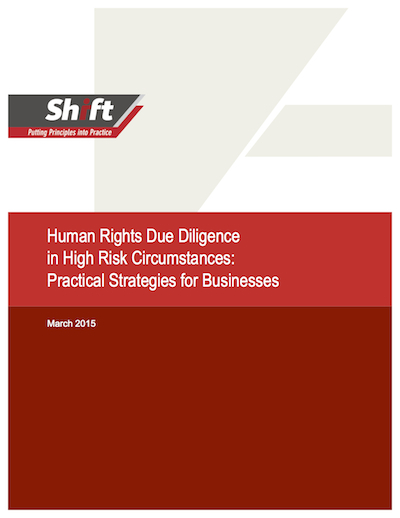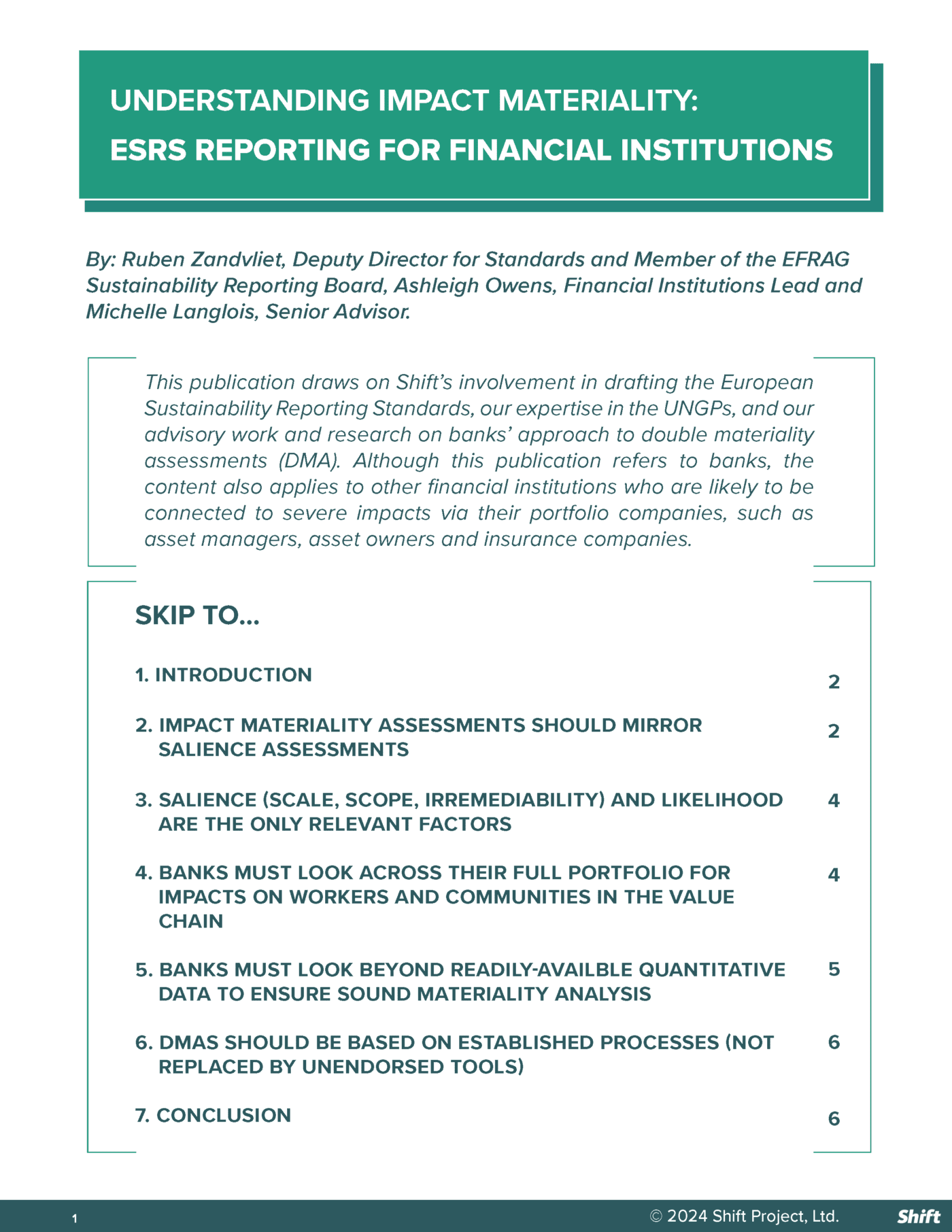PILLAR 2: CORPORATE RESPONSIBILITY TO RESPECT HUMAN RIGHTS
Foundational Principles
11. Business enterprises should respect human rights. This means that they should avoid infringing on the human rights of others and should address adverse human rights impacts with which they are involved.
___
Commentary
The responsibility to respect human rights is a global standard of expected conduct for all business enterprises wherever they operate. It exists independently of States’ abilities and/or willingness to fulfil their own human rights obligations, and does not diminish those obligations. And it exists over and above compliance with national laws and regulations protecting human rights.
Addressing adverse human rights impacts requires taking adequate measures for their prevention, mitigation and, where appropriate, remediation. Business enterprises may undertake other commitments or activities to support and promote human rights, which may contribute to the enjoyment of rights. But this does not offset a failure to respect human rights throughout their operations.
Business enterprises should not undermine States’ abilities to meet their own human rights obligations, including by actions that might weaken the integrity of judicial processes.
12. The responsibility of business enterprises to respect human rights refers to internationally recognized human rights – understood, at a minimum, as those expressed in the International Bill of Human Rights and the principles concerning fundamental rights set out in the International Labour Organization’s Declaration on Fundamental Principles and Rights at Work.
___
Commentary
Because business enterprises can have an impact on virtually the entire spectrum of internationally recognized human rights, their responsibility to respect applies to all such rights. In practice, some human rights may be at greater risk than others in particular industries or contexts, and therefore will be the focus of heightened attention. However, situations may change, so all human rights should be the subject of periodic review.
An authoritative list of the core internationally recognized human rights is contained in the International Bill of Human Rights (consisting of the Universal Declaration of Human Rights and the main instruments through which it has been codified: the International Covenant on Civil and Political Rights and the International Covenant on Economic, Social and Cultural Rights), coupled with the principles concerning fundamental rights in the eight ILO core conventions as set out in the Declaration on Fundamental Principles and Rights at Work. These are the benchmarks against which other social actors assess the human rights impacts of business enterprises. The responsibility of business enterprises to respect human rights is distinct from issues of legal liability and enforcement, which remain defined largely by national law provisions in relevant jurisdictions.
Depending on circumstances, business enterprises may need to consider additional standards. For instance, enterprises should respect the human rights of individuals belonging to specific groups or populations that require particular attention, where they may have adverse human rights impacts on them. In this connection, United Nations instruments have elaborated further on the rights of indigenous peoples; women; national or ethnic, religious and linguistic minorities; children; persons with disabilities; and migrant workers and their families. Moreover, in situations of armed conflict enterprises should respect the standards of international humanitarian law.
13. The responsibility to respect human rights requires that business enterprises:
(a) Avoid causing or contributing to adverse human rights impacts through their own activities, and address such impacts when they occur;
(b) Seek to prevent or mitigate adverse human rights impacts that are directly linked to their operations, products or services by their business relationships, even if they have not contributed to those impacts.
___
Commentary
Business enterprises may be involved with adverse human rights impacts either through their own activities or as a result of their business relationships with other parties. Guiding Principle 19 elaborates further on the implications for how business enterprises should address these situations. For the purpose of these Guiding Principles a business enterprise’s “activities” are understood to include both actions and omissions; and its “business relationships” are understood to include relationships with business partners, entities in its value chain, and any other non-State or State entity directly linked to its business operations, products or services.
14. The responsibility of business enterprises to respect human rights applies to all enterprises regardless of their size, sector, operational context, ownership and structure. Nevertheless, the scale and complexity of the means through which enterprises meet that responsibility may vary according to these factors and with the severity of the enterprise’s adverse human rights impacts.
___
Commentary
The means through which a business enterprise meets its responsibility to respect human rights will be proportional to, among other factors, its size. Small and medium-sized enterprises may have less capacity as well as more informal processes and management structures than larger companies, so their respective policies and processes will take on different forms. But some small and medium-sized enterprises can have severe human rights impacts, which will require corresponding measures regardless of their size. Severity of impacts will be judged by their scale, scope and irremediable character.
The means through which a business enterprise meets its responsibility to respect human rights may also vary depending on whether, and the extent to which, it conducts business through a corporate group or individually.
However, the responsibility to respect human rights applies fully and equally to all business enterprises.
15. In order to meet their responsibility to respect human rights, business enterprises should have in place policies and processes appropriate to their size and circumstances, including:
(a) A policy commitment to meet their responsibility to respect human rights;
(b) A human rights due diligence process to identify, prevent, mitigate and account for how they address their impacts on human rights;
(c) Processes to enable the remediation of any adverse human rights impacts they cause or to which they contribute.
___
Commentary
Business enterprises need to know and show that they respect human rights. They cannot do so unless they have certain policies and processes in place. Principles 16 to 24 elaborate further on these.
Operational Principles
POLICY COMMITMENT
16. As the basis for embedding their responsibility to respect human rights, business enterprises should express their commitment to meet this responsibility through a statement of policy that:
(a) Is approved at the most senior level of the business enterprise;
(b) Is informed by relevant internal and/or external expertise;
(c) Stipulates the enterprise’s human rights expectations of personnel, business partners and other parties directly linked to its operations, products or services;
(d) Is publicly available and communicated internally and externally to all personnel, business partners and other relevant parties;
(e) Is reflected in operational policies and procedures necessary to embed it throughout the business enterprise.
___
Commentary
The term “statement” is used generically, to describe whatever means an enterprise employs to set out publicly its responsibilities, commitments, and expectations.
The level of expertise required to ensure that the policy statement is adequately informed will vary according to the complexity of the business enterprise’s operations. Expertise can be drawn from various sources, ranging from credible online or written resources to consultation with recognized experts.
The statement of commitment should be publicly available. It should be communicated actively to entities with which the enterprise has contractual relationships; others directly linked to its operations, which may include State security forces; investors; and, in the case of operations with significant human rights risks, to the potentially affected stakeholders.
Internal communication of the statement and of related policies and procedures should make clear what the lines and systems of accountability will be, and should be supported by any necessary training for personnel in relevant business functions.
Just as States should work towards policy coherence, so business enterprises need to strive for coherence between their responsibility to respect human rights and policies and procedures that govern their wider business activities and relationships. This should include, for example, policies and procedures that set financial and other performance incentives for personnel; procurement practices; and lobbying activities where human rights are at stake.
Through these and any other appropriate means, the policy statement should be embedded from the top of the business enterprise through all its functions, which otherwise may act without awareness or regard for human rights.
Human Rights Due Diligence
17. In order to identify, prevent, mitigate and account for how they address their adverse human rights impacts, business enterprises should carry out human rights due diligence. The process should include assessing actual and potential human rights impacts, integrating and acting upon the findings, tracking responses, and communicating how impacts are addressed. Human rights due diligence:
(a) Should cover adverse human rights impacts that the business enterprise may cause or contribute to through its own activities, or which may be directly linked to its operations, products or services by its business relationships;
(b) Will vary in complexity with the size of the business enterprise, the risk of severe human rights impacts, and the nature and context of its operations;
(c) Should be ongoing, recognizing that the human rights risks may change over time as the business enterprise’s operations and operating context evolve.
___
Commentary
This Principle defines the parameters for human rights due diligence, while Principles 18 through 21 elaborate its essential components. Human rights risks are understood to be the business enterprise’s potential adverse human rights impacts. Potential impacts should be addressed through prevention or mitigation, while actual impacts – those that have already occurred – should be a subject for remediation (Principle 22).
Human rights due diligence can be included within broader enterprise risk management systems, provided that it goes beyond simply identifying and managing material risks to the company itself, to include risks to rights-holders. Human rights due diligence should be initiated as early as possible in the development of a new activity or relationship, given that human rights risks can be increased or mitigated already at the stage of structuring contracts or other agreements, and may be inherited through mergers or acquisitions.
Where business enterprises have large numbers of entities in their value chains it may be unreasonably difficult to conduct due diligence for adverse human rights impacts across them all. If so, business enterprises should identify general areas where the risk of adverse human rights impacts is most significant, whether due to certain suppliers’ or clients’ operating context, the particular operations, products or services involved, or other relevant considerations, and prioritize these for human rights due diligence. Questions of complicity may arise when a business enterprise contributes to, or is seen as contributing to, adverse human rights impacts caused by other parties. Complicity has both non-legal and legal meanings. As a nonlegal matter, business enterprises may be perceived as being “complicit” in the acts of another party where, for example, they are seen to benefit from an abuse committed by that party.
As a legal matter, most national jurisdictions prohibit complicity in the commission of a crime, and a number allow for criminal liability of business enterprises in such cases. Typically, civil actions can also be based on an enterprise’s alleged contribution to a harm, although these may not be framed in human rights terms. The weight of international criminal law jurisprudence indicates that the relevant standard for aiding and abetting is knowingly providing practical assistance or encouragement that has a substantial effect on the commission of a crime.
Conducting appropriate human rights due diligence should help business enterprises address the risk of legal claims against them by showing that they took every reasonable step to avoid involvement with an alleged human rights abuse. However, business enterprises conducting such due diligence should not assume that, by itself, this will automatically and fully absolve them from liability for causing or contributing to human rights abuses.
18. In order to gauge human rights risks, business enterprises should identify and assess any actual or potential adverse human rights impacts with which they may be involved either through their own activities or as a result of their business relationships. This process should:
(a) Draw on internal and/or independent external human rights expertise;
(b) Involve meaningful consultation with potentially affected groups and other relevant stakeholders, as appropriate to the size of the business enterprise and the nature and context of the operation.
___
Commentary
The initial step in conducting human rights due diligence is to identify and assess the nature of the actual and potential adverse human rights impacts with which a business enterprise may be involved. The purpose is to understand the specific impacts on specific people, given a specific context of operations. Typically this includes assessing the human rights context prior to a proposed business activity, where possible; identifying who may be affected; cataloguing the relevant human rights standards and issues; and projecting how the proposed activity and associated business relationships could have adverse human rights impacts on those identified.
In this process, business enterprises should pay special attention to any particular human rights impacts on individuals from groups or populations that may be at heightened risk of vulnerability or marginalization, and bear in mind the different risks that may be faced by women and men. While processes for assessing human rights impacts can be incorporated within other processes such as risk assessments or environmental and social impact assessments, they should include all internationally recognized human rights as a reference point, since enterprises may potentially impact virtually any of these rights.
Because human rights situations are dynamic, assessments of human rights impacts should be undertaken at regular intervals: prior to a new activity or relationship; prior to major decisions or changes in the operation (e.g. market entry, product launch, policy change, or wider changes to the business); in response to or anticipation of changes in the operating environment (e.g. rising social tensions); and periodically throughout the life of an activity or relationship.
To enable business enterprises to assess their human rights impacts accurately, they should seek to understand the concerns of potentially affected stakeholders by consulting them directly in a manner that takes into account language and other potential barriers to effective engagement. In situations where such consultation is not possible, business enterprises should consider reasonable alternatives such as consulting credible, independent expert resources, including human rights defenders and others from civil society. The assessment of human rights impacts informs subsequent steps in the human rights due diligence process.
19. In order to prevent and mitigate adverse human rights impacts, business enterprises should integrate the findings from their impact assessments across relevant internal functions and processes, and take appropriate action.
a) Effective integration requires that:
i) Responsibility for addressing such impacts is assigned to the appropriate level and function within the business enterprise;
ii) Internal decision-making, budget allocations and oversight processes enable effective responses to such impacts.
b) Appropriate action will vary according to:
i) Whether the business enterprise causes or contributes to an adverse impact, or whether it is involved solely because the impact is directly linked to its operations, products or services by a business relationship;
ii) The extent of its leverage in addressing the adverse impact.
___
Commentary
The horizontal integration across the business enterprise of specific findings from assessing human rights impacts can only be effective if its human rights policy commitment has been embedded into all relevant business functions. This is required to ensure that the assessment findings are properly understood, given due weight, and acted upon.
In assessing human rights impacts, business enterprises will have looked for both actual and potential adverse impacts. Potential impacts should be prevented or mitigated through the horizontal integration of findings across the business enterprise, while actual impacts—those that have already occurred – should be a subject for remediation (Principle 22).
Where a business enterprise causes or may cause an adverse human rights impact, it should take the necessary steps to cease or prevent the impact.
Where a business enterprise contributes or may contribute to an adverse human rights impact, it should take the necessary steps to cease or prevent its contribution and use its leverage to mitigate any remaining impact to the greatest extent possible. Leverage is considered to exist where the enterprise has the ability to effect change in the wrongful practices of an entity that causes a harm.
Where a business enterprise has not contributed to an adverse human rights impact, but that impact is nevertheless directly linked to its operations, products or services by its business relationship with another entity, the situation is more complex. Among the factors that will enter into the determination of the appropriate action in such situations are the enterprise’s leverage over the entity concerned, how crucial the relationship is to the enterprise, the severity of the abuse, and whether terminating the relationship with the entity itself would have adverse human rights consequences.
The more complex the situation and its implications for human rights, the stronger is the case for the enterprise to draw on independent expert advice in deciding how to respond.
If the business enterprise has leverage to prevent or mitigate the adverse impact, it should exercise it. And if it lacks leverage there may be ways for the enterprise to increase it. Leverage may be increased by, for example, offering capacity-building or other incentives to the related entity, or collaborating with other actors.
There are situations in which the enterprise lacks the leverage to prevent or mitigate adverse impacts and is unable to increase its leverage. Here, the enterprise should consider ending the relationship, taking into account credible assessments of potential adverse human rights impacts of doing so.
Where the relationship is “crucial” to the enterprise, ending it raises further challenges. A relationship could be deemed as crucial if it provides a product or service that is essential to the enterprise’s business, and for which no reasonable alternative source exists. Here the severity of the adverse human rights impact must also be considered: the more severe the abuse, the more quickly the enterprise will need to see change before it takes a decision on whether it should end the relationship. In any case, for as long as the abuse continues and the enterprise remains in the relationship, it should be able to demonstrate its own ongoing efforts to mitigate the impact and be prepared to accept any consequences – reputational, financial or legal – of the continuing connection.
20. In order to verify whether adverse human rights impacts are being addressed, business enterprises should track the effectiveness of their response. Tracking should:
(a) Be based on appropriate qualitative and quantitative indicators;
(b) Draw on feedback from both internal and external sources, including affected stakeholders.
___
Commentary
Tracking is necessary in order for a business enterprise to know if its human rights policies are being implemented optimally, whether it has responded effectively to the identified human rights impacts, and to drive continuous improvement.
Business enterprises should make particular efforts to track the effectiveness of their responses to impacts on individuals from groups or populations that may be at heightened risk of vulnerability or marginalization.
Tracking should be integrated into relevant internal reporting processes. Business enterprises might employ tools they already use in relation to other issues. This could include performance contracts and reviews as well as surveys and audits, using gender-disaggregated data where relevant. Operational-level grievance mechanisms can also provide important feedback on the effectiveness of the business enterprise’s human rights due diligence from those directly affected (see Principle 29).
21. In order to account for how they address their human rights impacts, business enterprises should be prepared to communicate this externally, particularly when concerns are raised by or on behalf of affected stakeholders. Business enterprises whose operations or operating contexts pose risks of severe human rights impacts should report formally on how they address them. In all instances, communications should:
(a) Be of a form and frequency that reflect an enterprise’s human rights impacts and that are accessible to its intended audiences;
(b) Provide information that is sufficient to evaluate the adequacy of an enterprise’s response to the particular human rights impact involved;
(c) In turn not pose risks to affected stakeholders, personnel or to legitimate requirements of commercial confidentiality.
___
Commentary
The responsibility to respect human rights requires that business enterprises have in place policies and processes through which they can both know and show that they respect human rights in practice. Showing involves communication, providing a measure of transparency and accountability to individuals or groups who may be impacted and to other relevant stakeholders, including investors.
Communication can take a variety of forms, including in-person meetings, online dialogues, consultation with affected stakeholders, and formal public reports. Formal reporting is itself evolving, from traditional annual reports and corporate responsibility/sustainability reports, to include online updates and integrated financial and non-financial reports.
Formal reporting by enterprises is expected where risks of severe human rights impacts exist, whether this is due to the nature of the business operations or operating contexts. The reporting should cover topics and indicators concerning how enterprises identify and address adverse impacts on human rights. Independent verification of human rights reporting can strengthen its content and credibility. Sector-specific indicators can provide helpful additional detail.
REMEDIATION
22. Where business enterprises identify that they have caused or contributed to adverse impacts, they should provide for or cooperate in their remediation through legitimate processes.
___
Commentary
Even with the best policies and practices, a business enterprise may cause or contribute to an adverse human rights impact that it has not foreseen or been able to prevent. Where a business enterprise identifies such a situation, whether through its human rights due diligence process or other means, its responsibility to respect human rights requires active engagement in remediation, by itself or in cooperation with other actors. Operational-level grievance mechanisms for those potentially impacted by the business enterprise’s activities can be one effective means of enabling remediation when they meet certain core criteria, as set out in Principle 31.
Where adverse impacts have occurred that the business enterprise has not caused or contributed to, but which are directly linked to its operations, products or services by a business relationship, the responsibility to respect human rights does not require that the enterprise itself provide for remediation, though it may take a role in doing so.
Some situations, in particular where crimes are alleged, typically will require cooperation with judicial mechanisms. Further guidance on mechanisms through which remediation may be sought, including where allegations of adverse human rights impacts are contested, is included in chapter III on access to remedy.
Issues of context
23. In all contexts, business enterprises should:
(a) Comply with all applicable laws and respect internationally recognized human rights, wherever they operate;
(b) Seek ways to honour the principles of internationally recognized human rights when faced with conflicting requirements;
(c) Treat the risk of causing or contributing to gross human rights abuses as a legal compliance issue wherever they operate.
___
Commentary
Although particular country and local contexts may affect the human rights risks of an enterprise’s activities and business relationships, all business enterprises have the same responsibility to respect human rights wherever they operate. Where the domestic context renders it impossible to meet this responsibility fully, business enterprises are expected to respect the principles of internationally recognized human rights to the greatest extent possible in the circumstances, and to be able to demonstrate their efforts in this regard.
Some operating environments, such as conflict-affected areas, may increase the risks of enterprises being complicit in gross human rights abuses committed by other actors (security forces, for example). Business enterprises should treat this risk as a legal compliance issue, given the expanding web of potential corporate legal liability arising from extraterritorial civil claims, and from the incorporation of the provisions of the Rome Statute of the International Criminal Court in jurisdictions that provide for corporate criminal responsibility. In addition, corporate directors, officers and employees may be subject to individual liability for acts that amount to gross human rights abuses.
In complex contexts such as these, business enterprises should ensure that they do not exacerbate the situation. In assessing how best to respond, they will often be well advised to draw on not only expertise and cross-functional consultation within the enterprise, but also to consult externally with credible, independent experts, including from Governments, civil society, national human rights institutions and relevant multi-stakeholder initiatives.
24. Where it is necessary to prioritize actions to address actual and potential adverse human rights impacts, business enterprises should first seek to prevent and mitigate those that are most severe or where delayed response would make them irremediable.
___
Commentary
While business enterprises should address all their adverse human rights impacts, it may not always be possible to address them simultaneously. In the absence of specific legal guidance, if prioritization is necessary business enterprises should begin with those human rights impacts that would be most severe, recognizing that a delayed response may affect remediability. Severity is not an absolute concept in this context, but is relative to the other human rights impacts the business enterprise has identified.
Watch the video below to learn more about salient human rights issues and how to identify them.






